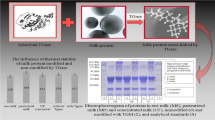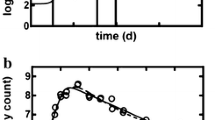Abstract
Sensitive ingredients of food, pharmaceutical products, or bioproducts can be damaged due to inappropriate processing conditions. The knowledge of the kinetics of degradation reactions allows optimizing production processes with regard to the nutritional quality. The essential amino acid lysine is an important nutrient in dairy powders that can be blocked, e.g., due to the Maillard reaction during drying processes. In this study, we showed that lysine loss can be modeled with pseudo-second-order reaction kinetics. The reaction rate constants increased with increasing temperature. At 90 °C, the highest reaction rate constant was found at a water activity of 0.23. This maximum was shifted to higher water activities for lower temperatures. The temperature dependence of the reaction rate constants could be modeled by the Williams–Landel–Ferry equation in the vicinity of the glass transition temperature and in the rubbery state. The glass transition temperature was calculated with the Gordon and Taylor equation. At higher temperatures and water contents, Arrhenius-type behavior was determined. The activation energy E A and the pre-exponential factor \( k_0^{*} \) of the Arrhenius equation were expressed as a function of the water content. Thus, it is possible to model lysine loss under conditions that are typical of the production of dairy powders as a function of the temperature, water content, and physical state. The established pseudo-second-order reaction kinetics model can be used to minimize lysine loss during the production of milk powder and to ensure a high nutritional quality.










Similar content being viewed by others
References
Charissou, A., Ait-Ameur, L., & Birlouez-Aragon, I. (2007). Kinetics of formation of three indicators of the Maillard reaction in model cookies: Influence of baking temperature and type of sugar. Journal of Agricultural and Food Chemistry, 55(11), 4532–4539.
Chavez-Servin, J. L., Castellote, A. I., & Lopez-Sabater, M. C. (2008). Evolution of available lysine and lactose contents in supplemented microencapsulated fish oil infant formula powder during storage. International Journal of Food Science and Technology, 43(6), 1121–1128.
Contreras-Calderon, J., Guerra-Hernandez, E., & Garcia-Villanova, B. (2009). Utility of some indicators related to the Maillard browning reaction during processing of infant formulas. Food Chemistry, 114(4), 1265–1270.
Fink, R., & Kessler, H. G. (1986). Erfassung und Berechnung der Lysinverluste gelagerter und erhitzter Milch. Ernahrungs-Umschau, 33(4), 121–124.
Ge Pan, G., & Melton, L. D. (2007). Nonenzymatic browning of lactose and caseinate during dry heating at different relative humidities. Journal of Agricultural and Food Chemistry, 55(24), 10036–10042.
Gordon, M., & Taylor, J. S. (1952). Ideal copolymers and the 2nd-order transitions of synthetic rubbers: 1. Non-crystalline copolymers. Journal of Applied Chemistry, 2(9), 493–500.
Greenspan, L. (1977). Humidity fixed points of binary saturated aqueous solutions. Journal of Research of the National Bureau of Standards: Section A-Physics and Chemistry, 81(1), 89–96.
Guerra-Hernandez, E., Leon, C., Corzo, N., Garcia-Villanova, B., & Romera, J. M. (2002). Chemical changes in powdered infant formulas during storage. International Journal of Dairy Technology, 55(4), 171–176.
Horak, F. P., & Kessler, H. G. (1981). The influence of UHT heating and sterilization on lysine in milk. Milchwissenschaft-Milk Science International, 36(9), 543–547.
Ilo, S., & Berghofer, E. (2003). Kinetics of lysine and other amino acids loss during extrusion cooking of maize grits. Journal of Food Science, 68(2), 496–502.
Karmas, R., Buera, M. P., & Karel, M. (1992). Effect of glass-transition on rates of nonenzymatic browning in food systems. Journal of Agricultural and Food Chemistry, 40(5), 873–879.
Labuza, T. P., & Saltmarch, M. (1981). Kinetics of browning and protein quality loss in whey powders during steady state and non-steady state storage conditions. Journal of Food Science, 47, 92–96.
Lievense, L. C., Verbeek, M. A. M., Taekema, T., Meerdink, G., & van’t Riet, K. (1992). Modeling the inactivation of Lactobacillus plantarum during a drying process. Chemical Engineering Science, 47(1), 87–97.
Li, X. M., Lin, S. X. Q., Chen, X. D., Chen, L. Z., & Pearce, D. (2006). Inactivation kinetics of probiotic bacteria during the drying of single milk droplets. Drying Technology, 24(6), 695–701.
Luyben, K. C. A. M., Liou, J. K., & Bruin, S. (1982). Enzyme degradation during drying. Biotechnology and Bioengineering, 24(3), 533–552.
Malec, L. S., Gonzales, A. S. P., Naranjo, G. B., & Vigo, M. S. (2002). Influence of water activity and storage temperature on lysine availability of a milk like system. Food Research International, 35(9), 849–853.
Meade, S. J., Reid, E. A., & Gerrard, J. A. (2005). The impact of processing on the nutritional quality of food proteins. Journal of AOAC International, 88(3), 904–922.
Miao, S., & Roos, Y. H. (2004). Nonenzymatic browning kinetics of a carbohydrate-based low-moisture food system at temperatures applicable to spray drying. Journal of Agricultural and Food Chemistry, 52(16), 5250–5257.
Moughan, P. J., & Rutherfurd, S. M. (2008). Available lysine in foods: A brief historical overview. Journal of AOAC International, 91(4), 901–906.
Pereyra Gonzales, A. S., Naranjo, G. B., Leiva, G. E., & Malec, L. S. (2010). Maillard reaction kinetics in milk powder: Effect of water activity at mild temperatures. International Dairy Journal, 20(1), 40–45.
Roos, Y. H., & Himberg, M. J. (1994). Nonenzymatic browning behavior as related to glass transition of a food model at chilling temperatures. Journal of Agricultural and Food Chemistry, 42(4), 893–898.
Schmitz, I., Gianfrancesco, A., Kulozik, U., & Foerst, P. (2011). Kinetics of lysine loss in an infant formula model system at conditions applicable to spray drying. Drying Technology, 29(16), 1876–1883.
Sloth, J., Bach, P., Jensen, A. D., & Kiil, S. (2008). Evaluation method for the drying performance of enzyme containing formulations. Biochemical Engineering Journal, 40(1), 121–129.
Thomsen, M. K., Olsen, K., Otte, J., Sjøstrøm, K., Werner, B. B., & Skibsted, L. H. (2012). Effect of water activity, temperature and pH on solid state lactosylation of β-lactoglobulin. International Dairy Journal, 23(1), 1–8.
Tomé, D., & Bos, C. (2007). Lysine requirement through the human life cycle. Journal of Nutrition, 137(6), 1642S–1645S.
van Boekel, M. A. J. S. (1998). Effect of heating on Maillard reactions in milk. Food Chemistry, 62(4), 403–414.
van Boekel, M. A. J. S. (2001). Kinetic aspects of the Maillard reaction: A critical review. Nahrung-Food, 45(3), 150–159.
van Boekel, M. A. J. S. (2009). Kinetic modelling of reactions in foods. Boca Raton: CRC Press, Taylor & Francis Group.
van Mil, P. J. J. M., & Jans, J. A. (1991). Storage stability of whole milk powder: Effects of process and storage conditions on product properties. Netherlands Milk and Dairy Journal, 45(3), 145–167.
Vuataz, G. (1988). Preservation of skim milk powders: Role of water activity and temperature in lactose crystallization and lysine loss. In C. Seow (Ed.), Food preservation by moisture control (pp. 73–101). London: Elsevier Applied Science.
Vuataz, G. (2002). The phase diagram of milk: A new tool for optimising the drying process. Le Lait, 82(4), 485–500.
Acknowledgments
The technical assistance of Carina Gerhard is gratefully acknowledged.
Author information
Authors and Affiliations
Corresponding author
Additional information
Source of Support
This project was supported by Nestec Ltd.
Rights and permissions
About this article
Cite this article
Schmitz-Schug, I., Kulozik, U. & Foerst, P. Reaction Kinetics of Lysine Loss in a Model Dairy Formulation as Related to the Physical State. Food Bioprocess Technol 7, 877–886 (2014). https://doi.org/10.1007/s11947-013-1119-3
Received:
Accepted:
Published:
Issue Date:
DOI: https://doi.org/10.1007/s11947-013-1119-3




